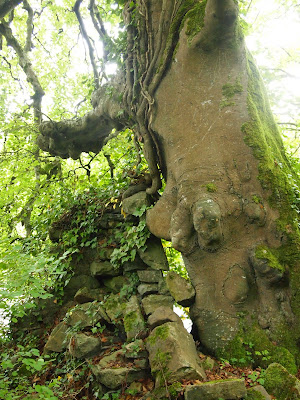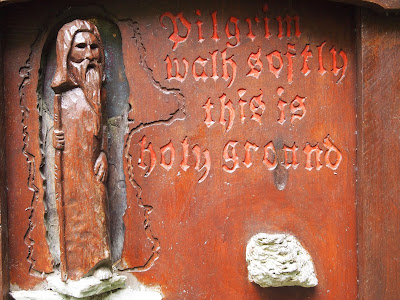Today we headed downtown, and after nearly a week of gray, rain, and cold, we even had a few spots of sun to cheer us on our way. Our goal- the Viking Museum, Dublinia, (which was supposed to be great for the kids) Christ Church Cathedral, and hopefully the Beatty Library again. We did manage the first two. And then we found a treat shop to end all treat shops. But that was at the end of the day.
Our day started, as always when going downtown, with the Luas- a relatively new, fast, quite, and clean public train system. We hopped on and got off at St. Stephen's Green downtown.
We headed up to Dublinia on foot, passing on our way the famous statue of Molly Malone. You probably know the tune...In Dublin's fair city, where girls are so pretty, I first set me eyes on sweet Molly Malone. She wheels her wheelbarrow through streets broad and narrow, singing "cockles and mussels alive, alive oh!" I will only casually mention that it does not look like just cockles or mussels that she is selling in the above statue.
Dublinia was, in fact, a great little museum. It has lots of interesting info (of which we did manage to read a little bit) but also lots of clothes for the girls to try on, tile rubbings for them to do, short movies to watch, etc.
It has three floors. The first explores Dublin's history during the Viking period, around 1100 A.D.
The second floor described Dublin during Medieval times. Reconstructionists here in Ireland often include bathroom scenes, we've noticed. The scene on this floor not only had a medieval bathroom, but a dummy sitting in the bathroom, making what sounded like a good old college try.
Yep, there were sound effects.
I couldn't bring myself to include a photo, so instead here is a photo of Kaia and Tessa in the stocks, looking tragic. It is something to consider if naughtiness gets out of hand.
I also took note of these fine shoes. They were the height of style for men of means. And the wooden clogs beside them slipped over the shoes for those times when walking in mud was unavoidable, even for the rich.
Since everything old once again becomes new, I think we can all agree that I've found my niche products, should I ever need to supplement my church income.
Minds expanded and financial problems solved, we headed across the street to Christ Church Cathedral. Christ Church has an interesting history, shifting from Catholic to Church of Ireland and also battling with St. Patrick's Cathedral (also Church of Ireland) for power. Thus serving as a reminder to all religious professionals that we will apparently never be rid of church politics. The power struggle between Christ Church and St. Patrick's was resolved in 1872, when Christ Church was named the diocesan cathedral for Dublin and Glendalough and St. Patrick's became a national cathedral.
Like St. Patrick's, Christ Church had amazing floor tiles. I don't know why I'm obsessed with these old tiles. I just love them.
On the off chance someone else also loves them, here are just a couple more shots of the tiles.
The tiles to the right are the original medieval tiles.
The cathedral also had a number of things I found fascinating, in a macabre sort of way. For example, this room is the "peace chapel." Pilgrims come here and pray for peace every evening.
Lovely.
But see that metal cage hanging on the wall? Inside it is a metal heart shaped box- appropriate enough for a peace chapel. But inside the metal, heart shaped box is a heart. By which I mean a human heart. The heart of Bishop Laurence O'Toole, to be precise, placed in the cathedral upon his (natural) death with "solemn rejoicing." I don't understand his history with the cathedral enough to know why that would be appropriate. Ahhh, within the worldview of those who would consider hanging a human heart inside a chapel to be appropriate.
Not passing judgement. Just admitting to being rather startled.
Beneath the cathedral are the crypts. We were allowed down, but given access to only a small section. We did not see any interred remains- that section was, I'm assuming kept closed, for which I'm glad. Some things deserve to be kept sacred. The part we were given access to held the cathedral's treasures. There was a very....crypt like atmosphere going down the stairs- low ceilings, dim lighting, old statues.
Until you rounded the corner, and ran into the gift shop and cafe.
Again, not passing judgement- after all, they have to pay their oil bill, too. And apparently during the 16th and 17th centuries, the crypts were accessed through separate doors and rented out for shops and "tippling rooms,"so they're hardly breaking with sacred tradition.
Directly across from the gift shop is displayed this mummified cat and rat, found a while back in the pipes, where they had apparently been trapped. I would have been more surprised, but then, I had just seen the caged heart.
All teasing aside, I had a very good feeling inside Christ Church- as if they took themselves seriously enough as religious folk (a prayer service was beginning as we left), but not too seriously. I thought they were probably my kind of people. And, just in case I'm assuming knowledge you don't have, many Catholic churches (and, I'm assuming, Anglican, of which Church of Ireland is one) hold parts of the human remains of saints to be holy relics. So as startling as it was to me to see a heart in the chapel, it is probably not startling to people within the tradition. Instead it likely really is received as a blessing. And though I've been joking, I'm really not judging.
We left Christ Church in search of a treat before we made our way home. And oh my, did we find it, here, at the Queen of Tarts. There are actually two in Dublin- we were at the larger, but this photo is of the smaller.
Lovers of baked goods, we have found your paradise. If you ever find yourself in Dublin, find this shop.
You can thank me when you get back.


























































